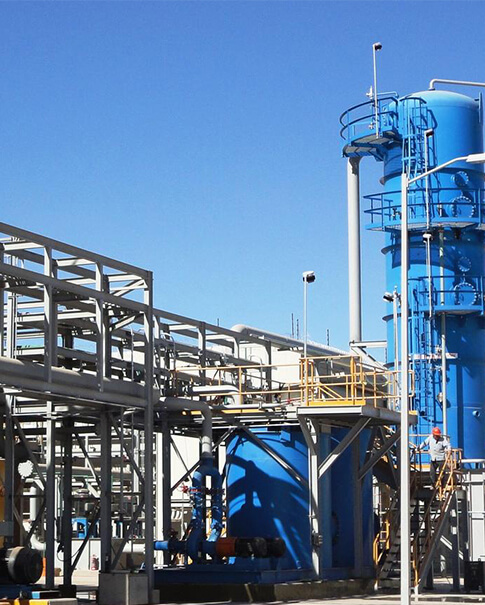
· merit
· Excellent pumping performance: It still has a high pumping speed at low inlet pressure. For example, JRP-150 in the series can reach 153 (m³/h), and JRP-2000 is even higher up to 2050 (m³/h), which can meet the needs of vacuum systems with large pumping speed at low inlet pressure, and can be used as the main pump or front-stage pump.
· No pollution: there is no friction between the rotor and the pump chamber, and no lubricating oil is needed. There is no oil in the pump chamber, which avoids the contamination of oil to the vacuum system. It is suitable for the working scene with high purity requirements of the vacuum environment, such as the production process of food and medicine industry.
· Structural and installation advantages: compact structure, small size, can be installed horizontally or vertically, flexible installation mode, can adapt to different space layout and equipment requirements.
· Good operation stability: with good dynamic balance, smooth operation, low vibration and low noise. Taking JRP series as an example, some models have low noise up to 63dB (A), which reduces the noise pollution generated during operation and is conducive to extending the service life of the equipment itself.
· Multi-functional design: The system features removable condensable gases, significantly expanding its application scope. An integrated bypass valve provides automatic overload protection, ensuring safe and reliable operation. When the pressure differential between intake and exhaust ports reaches a predetermined threshold, the valve automatically activates. This mechanism reduces operational load on high-pressure differential Roots pumps and auxiliary pumps, guaranteeing simultaneous startup of vacuum pumps and auxiliary pumps without overload.
· Economy and energy saving: fast start, can reach the limit pressure in a short time; low power, low operation and maintenance costs, reduced use costs.
· shortcoming
· The system requires integrated operation: It cannot function independently and must be combined with a preceding vacuum pump (such as rotary vane pump, slide valve pump, or water ring pump) to form a Roots pump unit. This configuration increases both equipment procurement costs and system complexity. To achieve higher vacuum levels, two Roots pumps must be connected in series to create a three-stage Roots pump unit, which further elevates both costs and system complexity.
· Affected parameters: Key performance parameters such as ultimate pressure and pumping rate are affected by the selection of the pre-vacuum pump. When different pre-vacuum pumps are selected, these parameters will change. In actual use, careful selection of the pre-vacuum pump is required to ensure that the working requirements are met, which increases the difficulty of selection and the cost of use.
1. In the vacuum packaging sector for food products, vacuum pumps play a vital role. By extracting air from packages to create a vacuum environment, they effectively prevent food oxidation and bacterial growth, ensuring product safety and preserving original flavors. A food company previously used 19 oil-rotating vane vacuum pumps in its stretch film vacuum packaging machines, with a total power output of 104.5KW. This setup not only caused oil mist emissions at exhaust ports that posed risks to workshop environments, worker health, and food safety, but also resulted in excessive noise, high energy consumption, frequent maintenance needs, and reduced product pass rates due to declining vacuum levels. The Gurebao team subsequently designed a new vacuum system solution for the company, utilizing two food-grade variable frequency screw vacuum pumps (GRB-1300VSD) paired with a Roots booster pump (GRB-2000LC) and a pretreatment unit. The optimized system dynamically adjusts frequency based on operational conditions, achieving up to 50% energy savings. Moreover, relocating the vacuum pumps to an independent workshop annex resolved issues like oil contamination, heat dissipation, and noise pollution, significantly enhancing both packaging quality and hygiene standards.
2. In the chemical production sector: A chemical plant upgraded its aging C8 ethylene extraction system's vacuum unit. The original wet Roots liquid ring vacuum unit was replaced with a dry Roots screw vacuum unit after renovation. The upgrade achieved remarkable results: significantly reduced energy consumption, enhanced system vacuum levels, lower operating temperatures, smoother system performance, decreased steam usage, reduced material polymerization risks, and improved product quality. This initiative met the goals of energy conservation, emission reduction, and quality enhancement. Annually, it saved 136,600 yuan in electricity costs, 1.2 million yuan in steam expenses, and eliminated 1,600 tons of waste oil or degraded oil processing volume. Additionally, it prevented shutdowns due to system blockages, substantially lowering overall plant operating costs.
3. Pharmaceutical Industry: BOC Edwards, a globally renowned chemical and pharmaceutical company, has implemented extensive dry vacuum pump systems in its production processes for pharmaceutical and chemical products. These systems effectively address exhaust gas emissions and contaminated oil issues while enabling one-time processing of large volumes of solvents and acidic gases such as hydrogen chloride and ammonia generated during manufacturing, thereby eliminating corrosion risks. For heat-sensitive brominated and chlorinated products, the dry vacuum pump system ensures successful drying processes. Furthermore, the adoption of dry vacuum technology and systems has driven advancements in the chemical and pharmaceutical industries, enabling the production of previously unattainable new drug formulations.